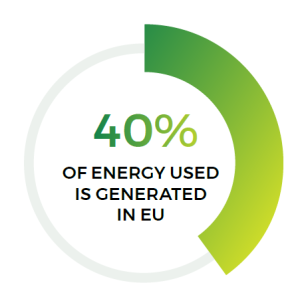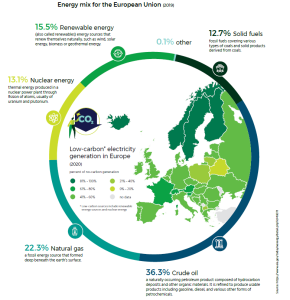2
Mojca Suvorov
European energy mix
To understand the energy system and the need for the energy transition, it is important to understand where the energy we use comes from.
When we think about energy sources, our mind usually wanders to the energy sources for electricity generation, such as coal, hydro, nuclear, and intermittent renewable sources, such as wind or the sun, but the biggest share of energy available in the European Union is petroleum products (36 %). They are followed by another fossil fuel – natural gas (22 %), together providing more than half of all energy used in Europe. Only then come renewable energy sources, with a 15 % share which includes the biggest renewable source – hydro energy. Nuclear energy, another low-carbon energy source, has a share of a little over 13 %. The last group of energy sources are solid fossil fuels, such as coal, coming in at 12.6 %, with a decline expected in the following years. The transition from a carbon-heavy to a low-carbon energy system will leave a big gap to fill with low-carbon energy sources. Energy communities can play a big role in the growth of clean energy production.
Is Europe energy self-sufficient?

Countries in the EU produce around 40 % of the energy they use, while the remaining 60 % is being imported. Of course, the percentage varies from country to country, with many countries even exporting their energy surplus. EU imports are dominated by crude oil and petroleum products, with 63 % of all imported energy coming from it, followed by natural gas with 26 %. The biggest suppliers of these energy sources are Russia (crude oil, natural gas, and fossil fuels) and Norway (crude oil and natural gas).
Energy transition – what does it mean?
The energy sector itself is responsible for over a quarter of all GHG emissions with just electricity production, not counting in the use of energy (e. g. heating and transport). The energy sector, however, is responsible for additional emissions in the transport, industry, and residential sectors. Due to the amount of emissions coming directly or indirectly from the energy sector (in total, over 75 %), it is one of the key players in achieving environmental and sustainability goals. The energy transition is the roadmap towards a more sustainable energy system, transforming from a fossil fuel-based to a low-carbon energy mix. It is one of the most complex challenges we face in light of global warming, due to the large amounts of infrastructure involved, as well as the necessity for energy in day-to-day life. The dependency on energy means that the transformation must be smooth, assuring reliable and efficient energy at every stage. The European Commission set the goal for the reduction of GHG emissions at 55 % by the year 2030 and net-zero by 2050.
What does the future hold?
The next few decades will see an increasing share of low-carbon sources, in line with global efforts to mitigate climate change. The growth of renewable energy brings new opportunities for active citizen involvement and decentralisation of energy systems. Energy communities can be great providers of energy generated from renewable sources and can actively participate in the energy transition with other activities, such as local energy distribution and energy storage.

